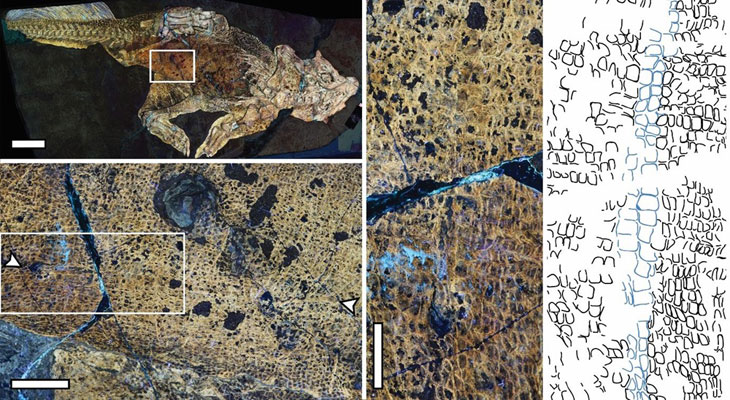An international team of paleontologists recently described the oldest known navel, from a 125 million-year-old dinosaur fossil found in China two decades ago.
The umbilical scar of a Psittacosaurus
belonging to the genus Psittacosaurusgroup of dinosaurs horned bipeds that roamed our planet at the beginning of the Cretaceous (about 145 to 100.5 million years ago), this herbivorous creature was about two meters long. By using the laser-induced fluorescence for analyze a fragment of fossilized skinresearchers from the Chinese University of Hong Kong have identified an attribute never before observed in these prehistoric reptiles : his navel.
” This imaging technique revealed the presence of distinctive scales around a long umbilical scar similar to that seen in some modern lizards and crocodiles. “, explains Michael Pittmann, lead author of the new study, published in the journal BMC Biology. ” This is the very first observation of a dinosaur navel, linked to the exceptional state of preservation of the fossil. »
Unlike humans and other mammals, dinosaurs (which were largely oviparous) did not have an umbilical cord. Their yolk sac was directly attached to their body through a slit-like opening also seen in other egg-laying land animals. At the time of hatching, this opening closes, leaving a characteristic long umbilical scar. Although scientists have long assumed that dinosaurs must have possessed such an attribute, this study is the first to support this hypothesis with fossil evidence.

” This Psittacosaurus specimen is probably the most important fossil we have for studying dinosaur skin “, estimates Phil Bell, of the university of New England. ” Its analysis using emerging technologies, such as laser imaging, continues to surprise us. »
An attribute that persisted until the sexual maturity of the dinosaur
According to the team, unlike most modern reptiles and birds, in which this scar disappears a few days or weeks after hatching, the Psittacosaurus umbilicus persisted at least until it reached sexual maturitylike a handful of lizards and crocodilians with which it has the greatest morphological proximity.
” This discovery is the oldest record of an amniote umbilicus and the first in a non-avian dinosaur “Says Bell. ” However, given the variability of this structure in extant reptilian analogues, it is possible that a persistent umbilical scar was not present in all non-avian dinosaurs.. »
Last year, British researchers described in detail the “hinds” of a dinosaur.
[related_posts_by_tax taxonomies=”post_tag”]
The post Scientists describe for the first time a… dinosaur navel appeared first on Gamingsym.

